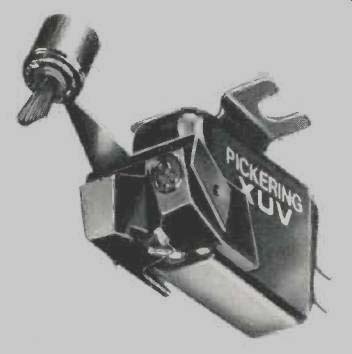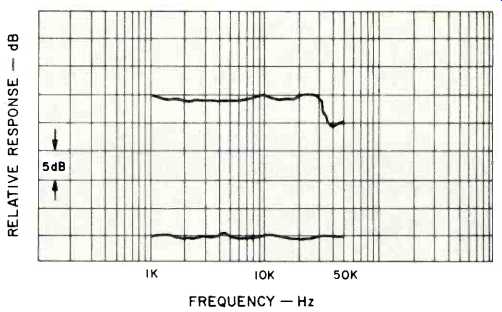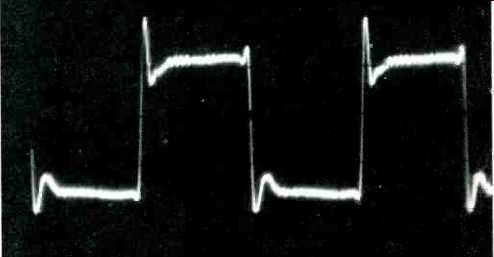
MANUFACTURER'S SPECIFICATIONS
Stylus Type: Quadrahedral. Stylus Tracking Force: One gram optimum. Output: 3.4 mV nominal re 5.5 cm/sec.
Channel Balance: ±1-1/2 dB maximum.
Separation: 35 dB at 1 kHz, 25 dB at 30 kHz.
Frequency Response: 10 to 50,000 Hz ±1-1/2 dB base bands, ±2 dB carrier bands.
Cartridge D.C. Resistance: 600 ohms.
Cartridge Inductance: 290 mH.
Weight: 6-1/2 grams, including 1 gram brush.
Load Resistance: 100 kOhms for four channel; 47 kOhms for two channel.
Load Capacitance: 100 pF including arm leads, cables, and amp for four channel; 275 pF for two channel.
Price: $139.95.
In 1973, Pickering's sister company, Stanton Magnetics, introduced the first American-made CD-4 cartridge, the 780/4DQ, which had a Shibata-like stylus shape called Quadrahedral. Experience with their first CD-4 cartridges and continuing research has led to a new design which retains the diamond Quadrahedral stylus tip. Like its predecessors, the cartridge comes equipped with a Dustamatic brush; for our tests, this brush was removed. The stylus assembly is easily replaced by pulling the assembly straight forward, separating it from the cartridge body.
The XUV/4500Q has a remarkably flat response from 20 Hz to 30 kHz, +1,-2 dB, and a separation averaging 23 dB from 20 Hz to 30 kHz. Separation at 20 kHz is 25 dB and 22.5 dB at 30 kHz, which is quite impressive. Pickering recommends a tracking force of one gram plus or minus one-half gram, and we found the optimum tracking force to be 1.15 gram for the cartridge tested, with an optimum anti skating force setting of 1.25 gram. Square waves indicate that the resonant frequency of the cartridge is about 32 kHz, with a fast rolloff. Its ability to track warped records with minimal distortion is good.
The Pickering XUV/4500Q ranks among the top cartridges for stereo, SQ, QS, and CD-4. The sonic clarity is exceptionally good, with superb transient and applause response, and good definition, particularly in the low bass region.
Measurements
As is our practice, measurements are made on both channels, but only the left channel is reported. During the test period, temperature was 73° F ± 1° and the relative humidity 55% ± 2%. Frequency response is flat within +1,-2 dB from 20 Hz to 30 kHz,-7.5 dB at 40 kHz, and-5 dB at 50 kHz. Separation is 25 dB at 1 kHz, 23 dB at 5 kHz, 24 dB at 10 kHz, 25 dB at 20 kHz, 22.5 dB at 30 kHz, 17 dB at 40 kHz, and 19.25 dB at 50 kHz. Channel balance is within a quarter dB and trackability is very good. A state-of-the-art CD-4 cartridge should produce more than 0.7 mV at 30 kHz from the JVC-1004 test record, where the 30-kHz monophonic signal is recorded at the 5.5-in. diameter with a peak velocity amplitude of 5 cm/sec. The XUV/4500Q output at 30 kHz was 0.95 mV. On a test record designed by this reviewer (AEL-100), which contains tracking velocities from 7 cm/sec. to 70 cm/sec. at 1 kHz, lateral cut, peak velocity, the XUV/4500Q tracked just under 28 cm/sec. Signal output is 0.68 mV/1-cm/sec.

Fig. 1--Frequency response and separation of the Pickering XUV/4500Q with
the JVC TRS-1005 test record.
The following adjustment and test records were used in making the reported measurements:
JVC 4DE-205; WEA PR186; Shure TTR-197, TTR-103, TTR-110; Columbia STR100, STR-112; JVC TRS-1004, TRS-1005; Stereo Review SR-12; B & K QR-2009, Deutsches Hi Fi No. 2; Panasonic SPR-111; Denon (UD-4) ST-5003; Ovation (QS) OVQS/4000; Columbia (SQ) SQT-1100, and AEL-100. Both the square wave photograph and 4:1 IM test were made using the new CBS Laboratories Professional Test Record, STR-112.
Wt., 5.59 g.; d.c. res., 591 ohms; Ind. 269 mH; Opt. tracking force, 1.15 g.; Opt. anti-skating force, 1.25 g.; Output, 0.68 mV/1-cm/sec; IM dist. (4:1) + 9 dB lateral, 200/4000: 2.1%, +6 dB vertical, 200/4000: 3.2%; Crosstalk, -28 dB; Ch. Bal., 0.25 dB; Trackability: High Freq. (10.8 kHz pulsed) 24 cm/sec.; Mid-freq. (1000 + 1500 Hz lat. cut) less than 20 cm/sec; Low freq. (400 + 4000 Hz lat. cut) 19 cm/sec; 30 kHz mono signal, 0.90 mV. Passed all bands of the Shure Audio Obstacle Course Era III test record. Cartridge-arm resonance (using Audio-technica AT-1009 arm) was less than 10 Hz.

Fig. 2--Square wave response of the Pickering XUV/4500Q with the CBS Labs STR-112 test record.
Listening Evaluation
We have used the XUV/4500Q cartridge with the following CD-4 demodulators in the listening evaluation: Technics SH-400, Panasonic SE-405, JVC 4DD-5, Harman/Kardon +44, and the Denon (UD-4) UDA-100, which also includes CD-4, SQ, and QS. Separation and 30-kHz carrier-signal adjustments (where required) were easily accomplished. Two Phase Linear 4000 preamplifiers and a pair of Crown D-150 amplifiers drove the speakers, primarily four Micro-Acoustics FRM-1's. A Technics SP-10 turntable with the Audio-technica AT-1009 tone arm was used for all tests, as well as the listening evaluation. A Janis Audio Associates W-1 subwoofer was used in combination with a Crown VFX2 crossover to reproduce all frequencies below 100 Hz.
A rigorous listening evaluation of the Pickering XUV/4500Q was made in both the stereo and quadraphonic mode, using all the records listed in Audio, March 1974, p. 39, those mentioned in Audio, September 1975, p. 60, and the following additional quadraphonic records which demonstrate the capabilities of this cartridge:
Yuri, Furi, Suri-JVC CD-4B5040
Steven Michael Schwartz-RCA Experimental Record, RL 1890 (mastered with the RCA Quadulator)
Carley Simon: Hotcakes-RCA Experimental Record, RL 1885 (mastered with the RCA Quadulator)
Levine Conducts Mahler-Symphonies Nos. 1 and 4 RCA CRD3-1040
Captain Blood-RCA ARD1-0912
Anthony Newman: Organ Orgy (A Wagner Sound Spectacular)- Columbia
MQ 33268 Chicago Ill-Columbia C2Q 30110
Orff: Carmina Burana-Columbia MQ 33172
Schoenberg: Gurre-Lieder-Columbia M2Q 33303
Most cartridges have a difficult time reproducing the last half-inch of Side A, Debussy: LaMer (RCA ARD1-0029). The Pickering XUV/4500Q reproduced this portion of the record with excellent clarity and definition, without the usual shattering sound. RCA recently produced two records for experimental use, Steven Michael Schwartz (RL-1890) and Carly Simon's Hotcakes (RL-1885), by mastering them with the new RCA Quadulator. Aside from the fine results brought about by the Quadulator, the XUV/4500Q reproduced the two recordings superbly. A remarkable Japanese recording, Yuri, Furl, Suri, presents Japanese musical instruments playing Japanese music. The recording is full of sharp transients that this cartridge was able to faithfully reproduce. To the best of our knowledge, Wagner's operatic music has never been recorded in modern times on a pipe organ. Columbia's Organ Orgy (MQ 33268) is played on the great Aeolian Skinner Organ of St. John the Divine, N.Y.C., by Anthony Newman. Despite all the sharp transients, very low pedal bass, and the usual Wagnerian fire and fury, the XUV/4500Q reproduced the recorded organ music faithfully, particularly the pedal bass, which not infrequently was below 30 Hz. The nine-ft. concert bass drum in Columbia's Carmina Burana was taken in its stride by the XUV/4500Q cartridge.
To sum up, we can recommend the Pickering XUV/4500Q cartridge without reservations, based upon our laboratory and listening tests.
-B. V. Pisha
(Audio magazine, Nov. 1975)
Also see:
Pickering XSV/3000 Stereo Cartridge (Equip. Profile, June 1977)
Pickering Model XV-15/750E Stereo Cartridge (Jan. 1970)
Pickering XSV/3000 phono cartridge (Dec. 1976), Pickering phono cartridges (Oct. 1977)
Ortofon MC 2000 Phono Cartridge and T 2000 Transform (Dec. 1984)
Micro Acoustics 630 Phono Cartridge (Mar. 1984)
Phono Equalization Kits--various models (Mar. 1979)
= = = =